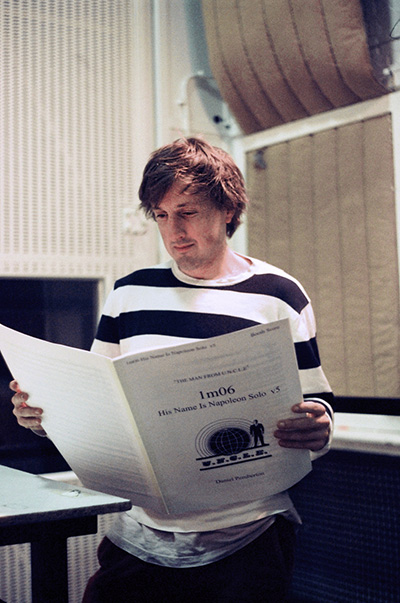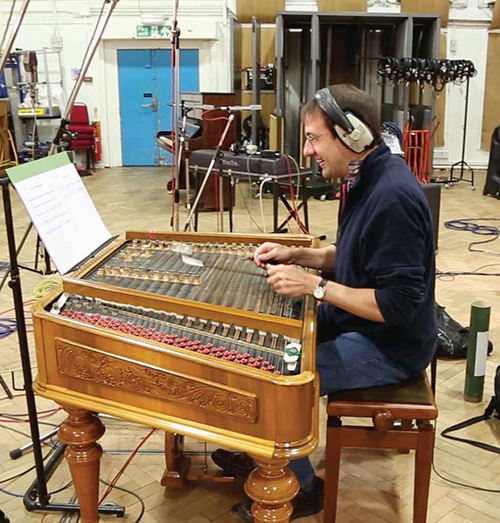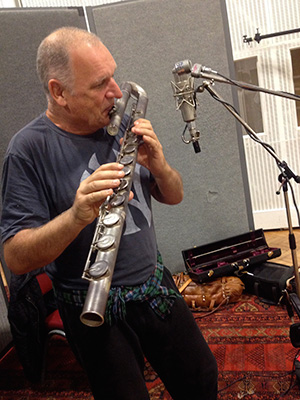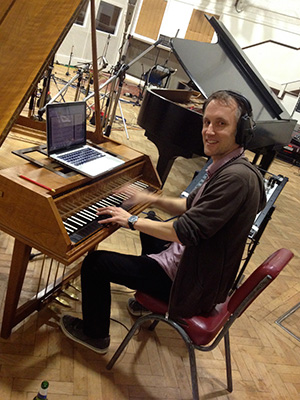

  |
|
|
||||||||||||||||||||||
|
FMS FEATURE... August 3, 2015 Daniel Pemberton: Music for The Man From U.N.C.L.E. English composer's '60s sounds propel big-screen spy adventure by Jon Burlingame  Daniel Pemberton during U.N.C.L.E. sessions at Abbey Road Studios English composer Daniel Pemberton has managed to match, musically, the stylish look that director Guy Ritchie has achieved with his long-awaited big-screen take on the 1964-68 series. The mood, tone and colors all involve vintage sounds from 50 years ago, with recording techniques to match. The result is one of the most delightful scores of the year. Pemberton musically charts the reluctant pairing of CIA agent Napoleon Solo (Henry Cavill) and KGB agent Illya Kuryakin (Armie Hammer) as they team to stop a 1963 nuclear-bomb plot involving a kidnapped scientist, his daughter (Alicia Viklander) and a ruthless businesswoman (Elizabeth Debicki) whose criminal organization is based in Rome. The film opens Aug. 14. Pemberton's score is the epitome of '60s cool as it propels the action, adds to the intrigue, reminds us of the locales, and hints at the emotions and high stakes. And it never sounds like James Bond.  Ed Cervenka on cimbalom during U.N.C.L.E. session. Pemberton, 37, remembers "catching a couple of reruns" of the U.N.C.L.E. series many years ago. "But I was familiar with, and fond of, the world of that kind of show, '60s spy TV dramas," including The Prisoner, The Persuaders and many of the other ITC-produced adventure shows (such as The Saint and Danger Man). "What I loved about those shows was, they always had really strong and interesting musical identities," he says. Pemberton, whose own TV resume includes the BBC's detective series Dirk Gently and spy series The Game, says "I was always trying to emulate that sort of feel, of classic TV theme tunes." He cites Jerry Goldsmith (U.N.C.L.E. ), Lalo Schifrin (Mission: Impossible), John Barry (The Persuaders) and Edwin Astley (Danger Man) as composers he admires from that era. Pemberton's Man From U.N.C.L.E. score is filled with musical sounds we associate with the spy films and series of the period: cimbalom (a Hungarian zither made famous in The Ipcress File), harpsichord (used in unexpectedly jazzy ways on Danger Man and U.N.C.L.E.), mandolin (used on both The Persuaders and The Adventurer themes), electric guitars and bass (reminiscent of Goldsmith's Our Man Flint films) and such offbeat, vintage instruments as the Marxophone and Jennings Univox. Add to those the bass flute, Hammond B3 organ and "every crazy piece of percussion we could get hold of – rototoms, boo-bams, bongos," and you have a definitive 1960s mix.  Dave Heath on bass flute during U.N.C.L.E. session. Instead of a full orchestra playing most of the time, Pemberton used smaller ensembles and layered the performances. "Sometimes we'd do a small band, like drums, guitar and bass, to get a good vibe. Other times we might do guitars on their own and really focus on how to get the coolest guitar sound. We spent a long time in the studio with a core group, giving ourselves time to experiment and hone the sound that we wanted." The cool, stealthy bass flute of well-known English flutist Dave Heath is a key aspect of the score. "He's breathing and playing very percussively," the composer explains. "He'd be in the studio doing these long takes, and people were looking at me, worried, and I'd say, 'Let's do another take!' He's a very fun character, and he liked being really pushed. Some of that flute playing is really hard." Another unique aspect of the score is Pemberton's insistence on doubling certain sounds, but not artificially – rather, two musicians playing live together. "We did two drummers playing a lot of the drum parts, synchronized, which gave us a huge drum sound. You've got two people hitting their drums like crazy, all the air in the room is being pushed around, and you're getting this huge sound that you wouldn't get overlaying a drum part." He also had two harpsichords – one of them played by conductor Andrew Skeet – and enjoyed creating new sounds by doubling unusual instruments (cimbalom and Marxophone, harpsichord and electric guitar, etc.) throughout.  Conductor Andrew Skeet on harpsichord during U.N.C.L.E. session. All of this was recorded in Studio Two at the legendary Abbey Road studio over two and a half weeks last September and October (and two more weeks of mixing after that). "Studio Two is the spiritual home of every great musical moment in the 1960s. I couldn't think of a better place to record a film like The Man From U.N.C.L.E.," he says. "That became our home." Abbey Road itself became another important element, from engineer Sam Okell's knowledge of the studio's fabled collection of old equipment to its echo-chamber room. "I wanted to make this sound as if it was recorded in the 1960s," Pemberton says (he even, briefly, considered recording it in mono; cooler heads prevailed). One 50-year-old mixing console "looked like a Soviet nuclear reactor" with its giant buttons; and the echo chamber came in handy in creating the reverb Pemberton wanted. "Some of the old equipment is still way more powerful and evocative than the most expensive computer software that you can get today." Pemberton spent nearly a year on the film, having begun while shooting was still underway last summer. "I prefer not to be a composer who just turns up the last couple of months and tidies things up. I like to get involved all the way through. It's very hard work, but it always results in a more unique score." Further heightening the pressure was director Ritchie's insistence on a score that sounded like a series of album tracks, Pemberton says. "That was one of the hardest things about this film, trying to write music that had its own musical integrity, as a stand-alone piece of music, but would still hit so many different moments in the action." Yet that's also what makes the album (released this Friday, Aug. 7) such a rewarding listen on its own.  "The film is beautiful," says Pemberton. "It's so stylish, so cool, and you're working with this wonderful world that is so full of color. The writing process of the score was one of the hardest things that I've done. But the recording process was probably the most fun I've ever had recording a film score." ©2015 Jon Burlingame |
Search
Past Features
|